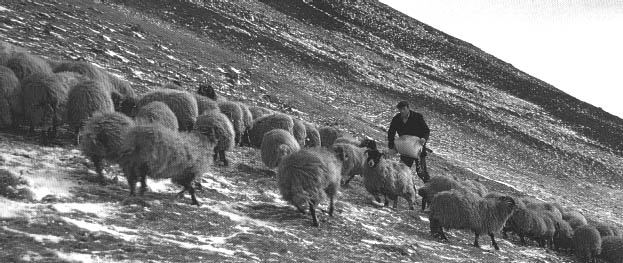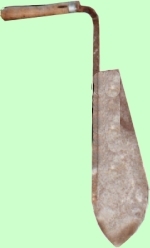The Farming Year in the Hills: Winter
December, January, February
Sheep

Sheep were left out in winter, since they weigh much less than cattle and do less damage to the land. They are also small enough to shelter behind walls, fallen trees, or in hollows. Hay, Uveca (flaked maize) and swede turnips were stored for them.
Sheep out on the fell land rarely got extra feed. Until comparatively recently, the stocking rates on the fell were low so the sheep could glean what they needed by just travelling a little further.
However, sheep on enclosed land were in need of more than just the thin winter grass, especially in a frosty or snowy period. Hay was fed when the weather was bad, and the other feeds were added as lambing time drew near.
"Very small ponies can be so very useful in harness. To have a pneumatic-tyred pony cart and a quiet pony is really most useful. There was a time when my men carried big sheets on their backs containing hay for stock out in the fields. From the hay sheds to the fields with a heavy sheet of hay was a big job. To-day, small pony carts do the job far more quickly and far more easily. They take out a load of
turnips, or carry sheep troughs from field to field, and do dozens of jobs about the farms which would require either a large horse, not economically employed, or perhaps two men..."
(R B Charlton, 1952, "A Lifetime with Ponies")
Turnips were taken out by cart to sheep in distant fields, but they were wheeled to nearer places in a barrow. One with extra top-boards like this would be used because turnips are round and waste a lot of space. Top boards also helped when a load was light and bulky rather than heavy, for instance when mucking out stables. A barrow such as this in the 1930s would have cost 62/- (£3-2s-0d) plain, and with top boards 75/- (£3-15s-0d). Currency translation
Cows
Cattle were "laid-in" in early October. The autumn rains quickly made the grassland very boggy and only the "store" cattle were left out - those intended for fattening once they had reached a decent size. Hay, Uveca and barley were the cattle's winter fare. Hay was the staple food and extra feeding was only given towards calving time.

In-calf cows were brought into stalls where they were tied to upright iron stays, using loops of rope round the neck, fastened with a wooden toggle. Usually the buildings were designed to hold two cows to a stall. A young cow unused to such restriction might fight the tie, but usually once the weather outside really "set in nasty", she settled.
Her neck tie was fastened to an iron loop that lay loose on the stay to allow the cow to stand or lie or lick herself, as she preferred. She was fed twice a day in the "fodder-gang" in front of her. She was bedded on bracken or straw, and her stall stood four or five inches higher than the muck channel behind it, which was cleaned out every evening while she was allowed out for water.
A cow in a byre is protected from the worst winter might do and comforted by her neighbours' presence, even though tied up all day and all night. Many a cow, let out into a black gale and sleet to take her day's water, has turned round and gone back in, preferring thirst, captivity and shelter to freedom and drinking in the cold and wet. Of course, if the farmer fell ill or neglected her she was totally helpless; but that was rare. Most farmers were and still are vigilant about the welfare of their stock.
For instance in the winter of 1962-63, John Gate and his family, who had only just moved into their new farm, dug and re-dug channels through the many feet of snow in the yard to get out and feed the cattle and sheep twice a day. They did it for months, until the snow thawed.

David Trotter (1950s): "Hay had to be cut out because it was all one big mass, you see. You’d to cut through half of the moo [stack] and take it away. You could use a hay knife in a silage pit too - take it out in beds. Well it all had to be transported, when all your cows were tied up by t’neck.
"In winter we used to feed the hay in creels, which were like hazel bits round, like a swill basket, and we’d cut a Uveca sack open and fasten it to the two, we used to call it a hay creel. And then fill it, and you could take it out to the outbuildings you see, you’d be carrying perhaps half a bale, whereas nowadays they just carry a bale, don’t they. It was the only means, unless they took it in armfuls, which was endless. Lot of hard work. You never thought owt about it really. I mean they wouldn’t do it today."